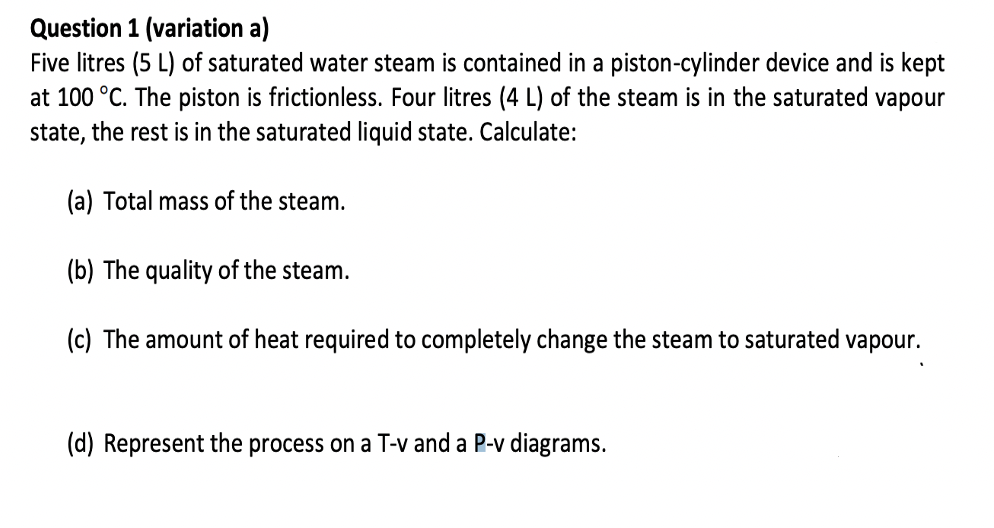Question 1 (variation a) Five litres (5 L) of saturated water steam is contained in a piston-cylinder device and is kept at 100 °C. The piston is frictionless. Four litres (4 L) of the steam is in the saturated vapour state, the rest is in the saturated liquid state. Calculate: (a) Total mass of the steam. (b) The quality of the steam. (c) The amount of heat required to completely change the steam to saturated vapour. (d) Represent the process on a T-v and a P-v diagrams.
Question 1 (variation a) Five litres (5 L) of saturated water steam is contained in a piston-cylinder device and is kept at 100 °C. The piston is frictionless. Four litres (4 L) of the steam is in the saturated vapour state, the rest is in the saturated liquid state. Calculate: (a) Total mass of the steam. (b) The quality of the steam. (c) The amount of heat required to completely change the steam to saturated vapour. (d) Represent the process on a T-v and a P-v diagrams.
Principles of Heat Transfer (Activate Learning with these NEW titles from Engineering!)
8th Edition
ISBN:9781305387102
Author:Kreith, Frank; Manglik, Raj M.
Publisher:Kreith, Frank; Manglik, Raj M.
Chapter8: Natural Convection
Section: Chapter Questions
Problem 8.3P
Related questions
Question

Transcribed Image Text:Question 1 (variation a)
Five litres (5 L) of saturated water steam is contained in a piston-cylinder device and is kept
at 100 °C. The piston is frictionless. Four litres (4 L) of the steam is in the saturated vapour
state, the rest is in the saturated liquid state. Calculate:
(a) Total mass of the steam.
(b) The quality of the steam.
(c) The amount of heat required to completely change the steam to saturated vapour.
(d) Represent the process on a T-v and a P-v diagrams.
Expert Solution
This question has been solved!
Explore an expertly crafted, step-by-step solution for a thorough understanding of key concepts.
Step by step
Solved in 3 steps with 2 images

Follow-up Questions
Read through expert solutions to related follow-up questions below.
Follow-up Question
For part c, shouldn't the mass be the mass of the liquid? not the entire mass?
Solution
Knowledge Booster
Learn more about
Need a deep-dive on the concept behind this application? Look no further. Learn more about this topic, mechanical-engineering and related others by exploring similar questions and additional content below.Recommended textbooks for you

Principles of Heat Transfer (Activate Learning wi…
Mechanical Engineering
ISBN:
9781305387102
Author:
Kreith, Frank; Manglik, Raj M.
Publisher:
Cengage Learning

Principles of Heat Transfer (Activate Learning wi…
Mechanical Engineering
ISBN:
9781305387102
Author:
Kreith, Frank; Manglik, Raj M.
Publisher:
Cengage Learning